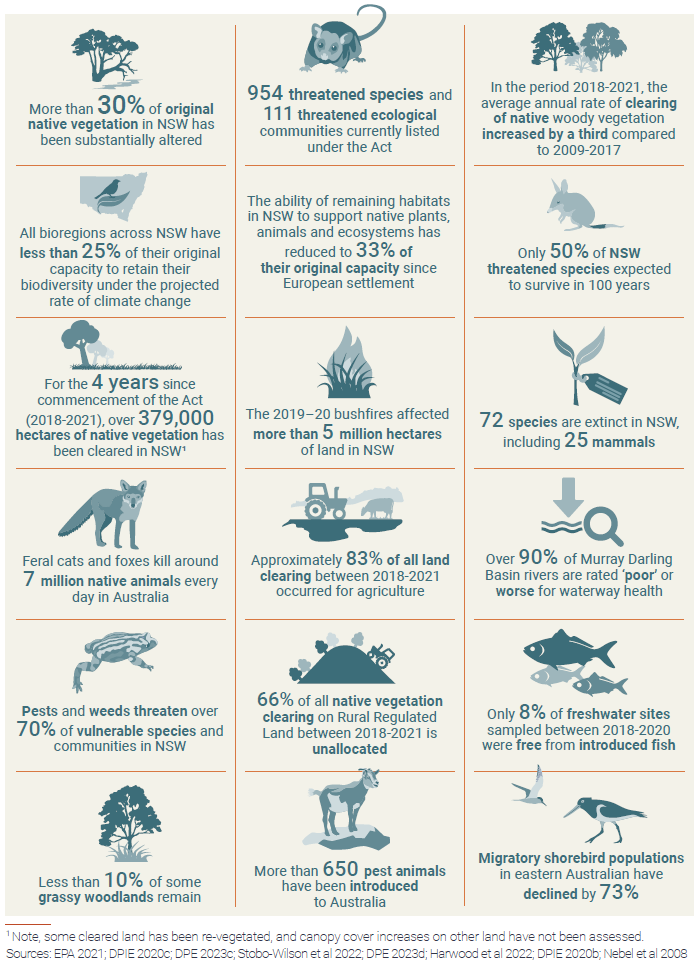


The Review Panel found that the present Biodiversity Conservation Act 2016 is not meeting its primary purpose of maintaining a healthy, productive and resilient environment, and is never likely to do so.
Biodiversity across NSW is at risk from a range of environmental disturbances:
• Clearing of native vegetation, intensifying land use, a growing population and associated infrastructure development has led to the destruction, alteration and fragmentation of habitat across the state.
• The effects of climate change are being felt, and are expected to become more pronounced. Projections show that extreme weather events such as bushfires, droughts, heatwaves, storms and floods will become more frequent and severe throughout NSW. Species and ecosystems are already being impacted, limiting their ability to adapt.
• Weeds are out-competing native plants and taking over large swathes of habitat, disrupting the natural balance of ecosystems and reducing species diversity.
• Feral animals are competing with native wildlife for resources, overgrazing native plants, and preying on native animals.
• Some of the biggest fires in NSW have occurred since 2002. The 2019–20 bushfires had a profound impact on biodiversity. Estimates suggest the fires affected more than 5 million hectares of habitat in NSW. These burnt habitats are more prone to altered fire regimes, particularly large-scale fires that burn at high intensity.
• The state’s major inland river systems continue to be affected by water extraction, altered river flows, loss of connectivity and catchment changes such as altered land use and vegetation clearing. These affect water availability, river health and ecosystem integrity.
• Native forest logging is damaging forest ecosystems and the habitat of native species.
The Review Panel found that the principal operative provisions of the Act, and their delivery, are deficient. This failure of the Act to achieve its principal purpose is contributing to the continuing deterioration of the environment. This impacts the wellbeing of all citizens of NSW.
As in other parts of the industrialised world, the supplies of several ecosystem services critical to production, including fresh water, arable soils and waste absorption, are rapidly declining. Further environmental damage puts at risk prospects for continued growth in the significant portion of the economy that is dependent on healthy ecosystems.
Since the Act was legislated, global ambition has moved beyond biodiversity conservation to a ‘nature positive’ framing that emphasises the need to repair past damage and to take urgent action to halt and reverse biodiversity loss, putting nature on a path to recovery, so that thriving ecosystems can support future generations.
The future wellbeing of the people of NSW rests upon beginning the repair of nature. The Review Panel considers that:
• In order to meet its objects, the Act should have primacy over competing pieces of legislation.
• Aboriginal people should be fully involved in the design and implementation of policy and programs designed to conserve and restore biodiversity.
• The Act should proactively address climate change impacts on biodiversity and ecosystems and the cumulative impact of biodiversity loss and loss of ecosystem connectivity.
• The Act should guide and promote investment in conservation and restoration activities, and should position NSW to take advantage of an emerging large-scale global investment in nature repair.
• Those affected by the regulatory provisions of the Act should have much greater certainty, face less complexity, and experience lower compliance costs, including through the development of a single spatial tool to clarify regulatory expectations.
• More needs to be done to expand credit supply by assisting landholders to enter Biodiversity Stewardship Agreements and giving greater credit value to restoring sites and protecting connected sites.
• Action should be taken to reduce the demand for credits through giving greater primacy to avoiding and minimising impacts, adjusting thresholds for small development and special measures to deal with very large projects to avoid crowding out the credit market.
• The focus of the Act should be shifted from threatened entities to strategic planning and management of biodiversity to ensure nature positive outcomes.
• All citizens should have confidence in the integrity of the programs administered under the Act.
• The government’s response to this review should consider the Australian Government’s reform of national legislation, ensuring alignment and streamlining where this does not impede NSW achieving its biodiversity objectives.
The review panel's key recommendation was to amend the Act to commit to an overarching object of ‘nature positive’, where biodiversity is protected, restored and improving, thereby ensuring the integrity of ecosystem services and cultural values, preserving opportunities for future generations.
Within that overarching object, the Act should commit to:
• halting and reversing biodiversity loss and ecosystem collapse
• restoring threatened species and ecosystems, ensuring the ecological and evolutionary potential of species and employing a landscape-level focus to building resilience and adaptive capacity, especially with respect to climate change
• zero human-induced extinctions of known threatened species
• a standard of net gain in biodiversity.